


JAN VERMEER
1632 -
Acknowledgements
Vermeer: The Lacemaker – The Louvre, Paris; Clio, the Muse of History – National Gallery of Art, Washington; View of Delft – Mauritshuis Museum, The Hague; Maidservant pouring milk – Rijksmuseum, Amsterdam; Lady with maidservant holding letter – Frick Collection, New York; The Astronomer – The Louvre, Paris; Girl with pearl earring – Mauritshuis Museum, The Hague. Hooch: Woman peeling apples – Wallace Collection, London; Interior Scene – National Gallery, London.
Including:
Pieter de
Hooch

xxxxxThe Dutch painter Jan Vermeer gained fame for his paintings of everyday scenes, noted for their fresh colours, subtle tones and soft light. Amongst his best work is The Lacemaker (1655), Maidservant Pouring Milk, Girl with the Pearl Earring, and his magnificent landscape View of Delft. He possibly used a camera obscura to help in the composition of his scenes, and in this respect he may well have known and been assisted by Antoni van Leeuwenhoek, a Dutch biologist who was interested in the use of lenses.
xxxxxJan Vermeer
(sometimes known as Jan van der Meer) was a Dutch genre painter
who was born in Delft and, apart from one short visit to The
Hague, appears to have stayed there all his life. He served a six
year apprentice, possibly under Carel Fabritius, a gifted pupil of
Rembrandt, and, after being admitted to the town's Guild of
Painters in 1653, became a prominent member. A painter of
peaceful, everyday scenes, his work is outstanding for the balance
and simplicity of his pictorial design, the purity and freshness
of his colours, and the subtle rendering of tone, texture and
light. Many of his paintings are noted for their precise,
geometrical construction, and the soft play of daylight with which
he i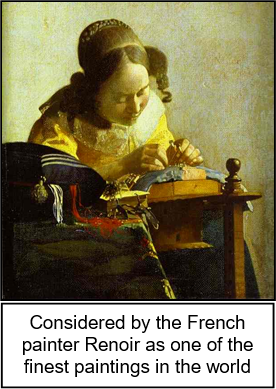 lluminates
the scene.
lluminates
the scene.
xxxxxHis early
paintings clearly show an Italian influence, as in Diana
and her Nymphs and Christ in the
House of Mary and Martha, but he quickly turned to the
quiet scenes of home life by which he is best known. His genre
paintings, many unrivalled in their beauty, include The
Lacemaker (illustrated) of 1655,
and Maidservant Pouring Milk, and
amongst his sunlit domestic interiors -
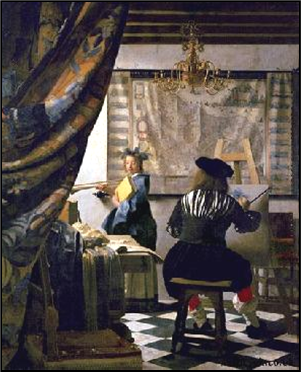 xxxxxOne of his masterpieces, The
Artist's Studio, shows the back view of an artist -
xxxxxOne of his masterpieces, The
Artist's Studio, shows the back view of an artist -
xxxxxIn this
landscape, and in some of his other paintings, Vermeer, may well
have used a camera obscura -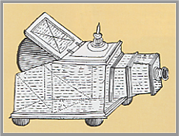 ther
artists of the day, was particularly useful in determining the
enlargement of detail in the foreground of a painting. As he
clearly made use of the camera obscura, it is possible that
Vermeer was acquainted with Antoni
ther
artists of the day, was particularly useful in determining the
enlargement of detail in the foreground of a painting. As he
clearly made use of the camera obscura, it is possible that
Vermeer was acquainted with Antoni
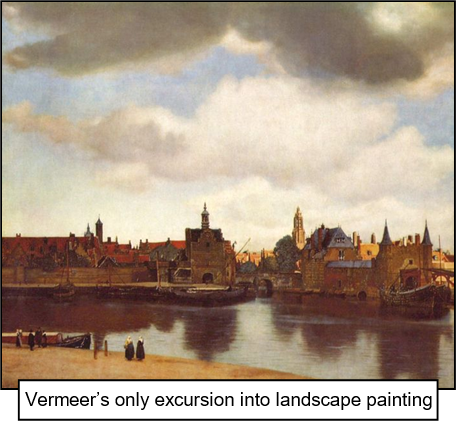 xxxxxLittle is known of Vermeer's life but it would seem
that he died in poverty at the age of 43, and was buried in the
Old Church at Delft. Soon afterwards his wife, Catharina, was
declared bankrupt. Such hardship was doubtless due to the needs of
a large family of eleven children. As an artist, he was a
methodical, slow worker and many of the paintings he did produce
were used to pay off household debts. He was an art dealer, like
his father before him, but he only made a modest living. Today,
only 35 authentic works remain, and his exceptional talent was not
really appreciated until he was "rediscovered" in the latter half
of the 19th century. Since then his reputation has grown
considerably, and he is now regarded as second only to Rembrandt
among Dutch artists of the 17th century.
xxxxxLittle is known of Vermeer's life but it would seem
that he died in poverty at the age of 43, and was buried in the
Old Church at Delft. Soon afterwards his wife, Catharina, was
declared bankrupt. Such hardship was doubtless due to the needs of
a large family of eleven children. As an artist, he was a
methodical, slow worker and many of the paintings he did produce
were used to pay off household debts. He was an art dealer, like
his father before him, but he only made a modest living. Today,
only 35 authentic works remain, and his exceptional talent was not
really appreciated until he was "rediscovered" in the latter half
of the 19th century. Since then his reputation has grown
considerably, and he is now regarded as second only to Rembrandt
among Dutch artists of the 17th century.
xxxxxIllustrated below (left to right) are Maidservant Pouring Milk, Lady with her Maidservant holding a Letter, The Astronomer, and one of his most enchanting works, The Girl with the Pearl Earring.
xxxxxIncidentally, it
is now known
that the notorious Dutch forger Hans van
Meegeren (1884-
xxxxx…… ThexDutch painter Carel Fabritius (1622-
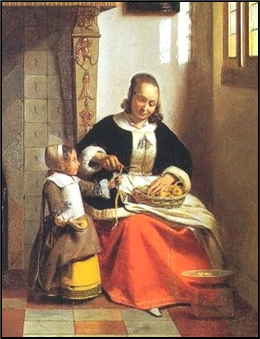
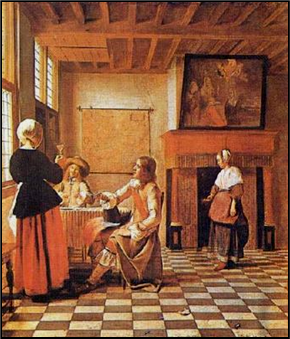 xxxxxA contemporary Dutch painter whose work showed a
close affinity with that of Vermeer was the Rotterdam artist Pieter de Hooch (1629-
xxxxxA contemporary Dutch painter whose work showed a
close affinity with that of Vermeer was the Rotterdam artist Pieter de Hooch (1629-
CW-



